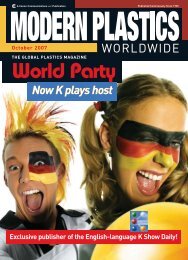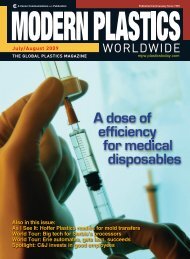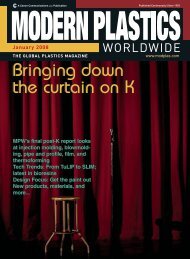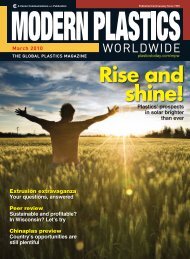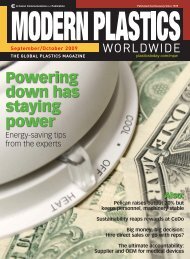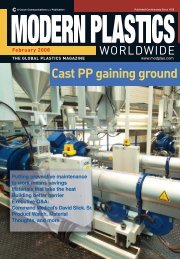amidiq - dae uptlax
amidiq - dae uptlax
amidiq - dae uptlax
Create successful ePaper yourself
Turn your PDF publications into a flip-book with our unique Google optimized e-Paper software.
306<br />
J. L. Arredondo-Figueroa et al./ Revista Mexicana de Ingeniería Química Vol. 6, No. 3 (2007) 301-308<br />
The nitrite (NO2 - ) averages were between 0.24<br />
and 0.64 mg/l with the highest values registered in<br />
the ST (Table 3). These values remained within the<br />
recommended range for rainbow trout culture<br />
(Klontz, 1991). Nitrite concentration decreased as<br />
fish density increased, although there was significant<br />
differences (p ≤ 0.05) among fish load rate with<br />
respect to nitrite concentration. Hence, it can be<br />
concluded that the population of nitrifying bacteria<br />
was rapidly adjusted as a response of high ammonia<br />
concentration in similar manner as in a stabilized<br />
system. Some authors (Saeki, 1963; Kawai et al.,<br />
1965; Liao and Mayo, 1974) reported similar<br />
patterns, although studied ammonia and nitrite<br />
concentrations were different. Similarly, as TAN the<br />
nitrite toxicity can be reduced or blocked by chlorine<br />
ions, usually 5 to 6 parts of chlorine protect fish from<br />
1 part of nitrite (Masser et al., 1992).<br />
Adjustment of nitrifying bacteria population<br />
can be detected, when nitrate behavior is analysed.<br />
This parameter increased regardless of rainbow trout<br />
load rate reduction with a noticeable further decrease<br />
in the third phase of the experiment. This fact can<br />
occur as a result of nitrifying bacteria adaptation due<br />
to a decrease in ammonia concentration and<br />
adjustment to new conditions.<br />
Average nitrate (NO3 - ) values fluctuated from<br />
23.3 to 28.6 mg/l. Non-significant differences (p ≥<br />
0.05) were observed between sample sites, except in<br />
the low load rate (89 kg) where FT presented<br />
significantly differences (p ≤ 0.05) with the other<br />
sites (Table 3). Nitrate is relatively non-toxic except<br />
at very high concentrations (over 300 mg/l) but<br />
usually does not reach these values. In many<br />
recirculating-water systems, some denitrification<br />
seems to occur within the system keeping nitrate<br />
concentration below toxic levels (Masser et al.,<br />
1992).<br />
References<br />
Alabaster, J. S., Shurben, D. G: and Mallett, M. J.<br />
(1979). The effect of dissolved oxygen and<br />
salinity on the toxicity of ammonia to smolts<br />
of salmon. Salmo salar L. Journal of Fish<br />
Biology 15, 705-712.<br />
Arredondo-Figueroa, J. L. and Lozano-Gracia, S. D.<br />
(1994). Water quality and yields in a<br />
polyculture of non-native cyprinids in Mexico.<br />
Hidrobiológica 4(1-2), 1-8.<br />
Arredondo-Figueroa, J. L., Valdivia-Soto, R. H.,<br />
Hernández-Lastiri, L. y Campos-Verduzco, R.<br />
(1996). Evaluación del crecimiento, factor de<br />
conversión de alimento y calidad del agua del<br />
cultivo de trucha arco iris (Oncorhynchus<br />
mykiss) en un sistema cerrado. Hidrobiológica<br />
6(1-2), 59-65.<br />
Avnimelech, Y. and Lacher, M. (1979). A tentative<br />
nutrient balance for intensive fish ponds.<br />
Bamidgeh 31, 3-8.<br />
Burrows, R. E. (1964). Effects of accumulated<br />
excretory products on hatchery-reared<br />
salmonids. U.S. Bur. Sport Fish. Wildl. Res.<br />
Rep. 66.<br />
Burrows, R. E. and Combs, B. D. (1968). Controlled<br />
environment for salmon propagation.<br />
Progressive Fish-Culturist 30, 123-136.<br />
Burkhalter D. F., and Kaya, C. M. (1977). Effects of<br />
prolonged exposure trout. Transaction of the<br />
American Fishery Society 106(5), 470-475<br />
Campbell J. W., (1973). Nitrogen excretion. In:<br />
Comparative animal physiology. (U. L.<br />
Prosset, ed.), Pp. 279-346. W B Saunders,<br />
Philadelphia. USA.<br />
Chen, S., Ling, J., and Blancheton, J. P. (2006).<br />
Nitrification kinetics of biofilm as affected by<br />
water quality factors. Aquaculture<br />
Engineering 34, 179-197.<br />
Chiang, H. C. and Lee, J. C. (1986). Study of<br />
treatment and reuse of aquacultural waster in<br />
Taiwan. Aquacultural Engineering 5, 301-<br />
312.<br />
Colt, J. E. and Amstrong, D. A. (1981). Nitrogen<br />
toxicity to fish, crustaceans and mollusks. In:<br />
Proceedings of the bioengineering symposium<br />
for fish culture. (American Fisheries Society,<br />
Fish Culture Section, ed.), Pp. 39-41.<br />
Bethesda, Maryland, USA.<br />
Colt, J. (2006). Water quality requirements for reuse<br />
systems. Aquaculture Engineering 34, 143-<br />
156.<br />
Crab, R., Avinimelech, Y., Defoirdt, T., Bossier, P.,<br />
and Verstraete, W. (2007). Nitrogen removal<br />
techniques in aquaculture for the sustainable<br />
production. Aquaculture 270, 1-14.<br />
Craig, S. R., Hatch, S. J. and Holt, G. J. (1990).<br />
Biological filter for conical tanks. Progressive<br />
Fish-Culturist 52, 61-62.<br />
DeWitt, J. W., and Saloa, E. A. (1960). An<br />
experiment with the complete recirculation of<br />
water. Progressive Fish-Culturist 22, 3-6.<br />
Emerson, K., Russo, C. R., Lund, E. R. and<br />
Thurston, V. R. (1975). Aqueous ammonia<br />
equilibrium calculations: effects of pH and<br />
temperature. Journal of Fisheries Research<br />
Board of Canada 32, 2379-2383.<br />
Franco-Nava, M. A., Blancheton, J. P., Deviller, G.,<br />
Charrier, A., and Le-Gall, J. Y. (2004). Effect<br />
of fish size and hydraulic regime on<br />
particulate organic matter dynamics in a<br />
recirculating aquaculture system: elemental<br />
carbon and nitrogen approach. Aquaculture<br />
239, 179-198.<br />
Gutierrez-Wing, M. T., and Malone, R.F. (2006).<br />
Biological filters in aquaculture: trends and<br />
research directions for freshwater and marine<br />
applications. Aquaculture Engineering 34,<br />
163-171<br />
Heinsbroek, L. T. and Kamstra, N. A. (1990). Design<br />
and Performance of Water Recirculation



